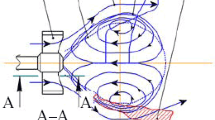Abstract
Some basic concepts and features of supersonic combustion are explained from the view point of macroscopic aerodynamics. Two kinds of interpretations of supersonic combustion are proposed. The difference between supersonic combustion and subsonic combustion is discussed, and the mechanism of supersonic combustion propagation and the limitation of heat addition in supersonic flow are pointed out. The results of the calculation of deflagration in supersonic flow show that the entropy increment and the total pressure loss of the combustion products may decrease with the increase of combustion velocity. It is also demonstrated that the oblique detonation wave angle may not be controlled by the wedge angle under weak underdriven solution conditions and be determined only by combustion velocity. Therefore, the weak underdriven solution may become self-sustaining oblique detonation waves with a constant wave angle.
Similar content being viewed by others
References
Heiser, W. H., Pratt, D. T.,Hypersonic Airbreathing Propulsion, Washington D. C.: AIAA Inc., 1994.
Beach, H., Lee, Jr., Supersonic combustion status and issues,Major Research Topics in Combustion (ed. Hussaini, M. Y.), New York: Springer-Verlag, 1993, 1–15.
Liu Ling,Supersonic Combustion and Scramjets (in Chinese), Xi’an: North West Tech. Univ. Publish Agency, 1993.
Walker, R. W., Position paper on chemical kinetics of combustion processes,Major Research Topics in Combustion (ed. Hussaini, M. Y.), New York: Springer-Verlag, 1993, 277–308.
Builder, C. H.,On the Thermodynamic Spectrum of Airbreathing Propulsion, Washington D. C.: AIAA Inc., 1964, p64.
Shapiro, A. H.,Dynamics and Thermodynamics of Compressible Fluid Flow, New York: Ronald Press Company, 1953, 231.
Strehlow, R. A.,Combustion Fundamentals, New York: McGraw-Hill Book Company, 1984.
Yuan, S., Huang, Z.,Optimality of C-J Oblique Detonation as Supersonic Combustion Modes, Washington D. C.: AIAA 1993, 93–3015.
Billig, F. S., Dugger, G. L., The interaction of shock waves and heat addition in the design of supersonic combustors,12th Symposium (International) on Combustion, Poitiers France, 1968, 1125–1134.
Kenneth, K.,Principles of Combustion, New York: John Wiley, 1986.
Pratt, D. T., Humphrey, J. W., Glenn, D. E.,Morphology of a Standing Oblique Detonation Wave, Washington D. C.: AIAA Inc., 1987, 87.
Author information
Authors and Affiliations
Additional information
Project supported by the National Natural Science Foundation of China (Grant Nos. 9482010, 59686005).
Rights and permissions
About this article
Cite this article
Yuan, S. On supersonic combustion. Sci. China Ser. A-Math. 42, 171–179 (1999). https://doi.org/10.1007/BF02876569
Received:
Issue Date:
DOI: https://doi.org/10.1007/BF02876569




